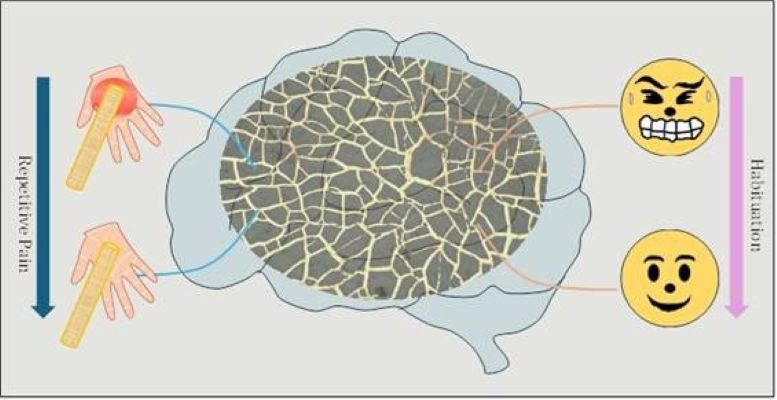Team L&M
Using silver wire network on a stretchable material, scientists have developed a device that senses strain, mimics pain perception and adapts its electrical response accordingly. By recreating these pain-like responses, the device paves the way for future smart wearable systems that can help doctors detect stress.
In today’s world, technology that can feel and adapt like human senses is increasingly valuable. Areas ranging from healthcare to robotics, needs materials that can “sense” stress or pain. They can enhance safety, make wearable tech smarter, and improve human-machine interactions.
Neuromorphic devices—technology inspired by the brain—gives ideas about how the human body senses and responds to pain. In our bodies, special sensors called nociceptors detect pain and help us respond to harmful situations. Over time, with repeated exposure, one can actually feel pain less intensely through a process called habituation.
Scientists from Jawaharlal Nehru Centre for Advanced Scientific Research (JNCASR), Bengaluru, an autonomous institute of Department of Science and Technology were inspired by this idea and ventured to create a sensor that not only detects strain but also adapts and “learns” from it. Using a network of tiny silver wires embedded in a flexible, stretchable material they developed a material that can sense strain and adjust its response over time.
When the material is stretched, small gaps appear within the silver network, temporarily breaking the electrical pathway. An electric pulse can then prompt the silver to fill these gaps, reconnecting the network and essentially “remembering” the event. Each time it is stretched and reconnected, the device gradually adjusts its response, much like how our bodies adapt to repeated pain over time. This dynamic process enables the device to mimic memory and adaptation, bringing humans closer to materials that respond intelligently to their environment.
The device sets itself apart by combining sensing and adaptive response in a single, flexible unit and offers a streamlined, efficient way for technology to adapt to its environment naturally, without complex setups or external sensors.
The research, published in the journal Materials Horizons, Royal Society of Chemistry (RSC) could lead to more advanced health monitoring systems that “feel” stress like the human body and adapt in real-time, giving feedback to doctors or users. Such technology could also improve robotic systems, helping machines become safer and more intuitive to work with humans.
